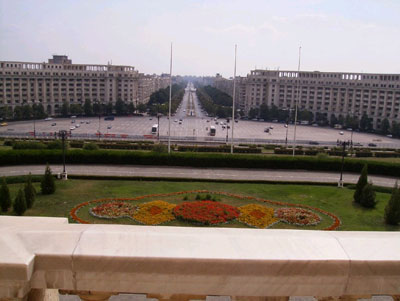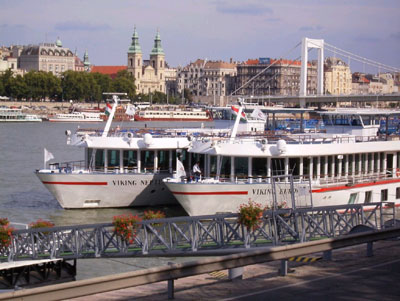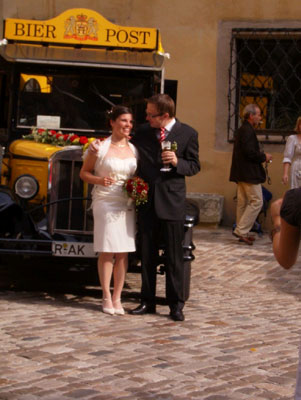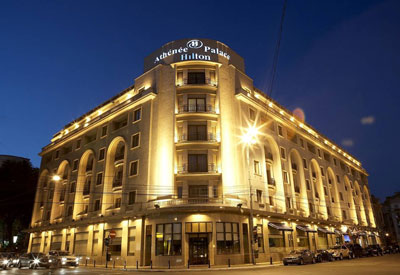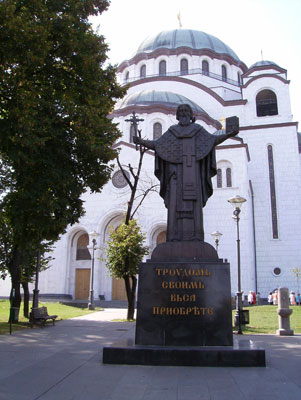Cruising the Danube — Eastern European discoveries
by Deanna Palic, Contributing Editor
My obsession with the Eastern Bloc countries began with the long-running 1950s TV series “Foreign Intrigue.” It wasn’t until 1981, however — when the Bloc was still behind the Iron Curtain — that I joined a land tour for an eye-opening 3-week visit to that completely different world. It was the era of the Brandenburg Gate and Checkpoint Charlie, which separated West and East Berlin and the rest of the Bloc from the Western world.
More recently, I was presented an opportunity to revisit some of those destinations and explore new ones as a guest of Viking River Cruises. So in August ’08 I did just that, embarking on their 16-day “Eastern European Odyssey” aboard the 150-passenger Viking Neptune.
Jetting there
Los Angeles is one of Lufthansa’s (800/645-3880, www.lufthansa.com) 22 North American gateways offering nonstop service to Germany, with connections from there to over 400 destinations worldwide. I traveled to Bucharest via Munich. Routing also was available via Frankfurt, but I preferred Lufthansa’s late-evening departure from Los Angeles in order to maximize my day at the office.
In searching the Internet for the least expensive fare, I was unable to locate fares lower than those offered by Viking River Cruises. It seems that the number of their passengers traveling on Lufthansa allows them to offer preferential rates.
On my flights, cabin attendants were courteous and attentive, and the meals were tasty, particularly the pasta entrées. Cocktails were complimentary, along with a selection of wines to accompany the meal.
The lavatories remained impeccably clean throughout my long flights. The lavatory configuration on Lufthansa’s Air Bus A340-600 is unique. The lower deck in economy is devoted to lavatories, with only a couple located on the passenger deck. This eliminates long lines in the aisles.
The stage is set
I arrived in Bucharest a day early, staying an extra night at the Athénée Palace Hilton (1-3 Episcopiei St., District 1; phone 011 40 21 303 3777, www1.hilton.com), an excellent hotel choice by Viking.
The hotel, which has been at the heart of Bucharest’s political and social life since its opening in 1914, exudes history. The lobby areas are lined with historic photos of the hotel from its inception. Bucharest’s major attractions, shops, trendy restaurants and cafés are close by.
One night, including breakfast and dinner, was included as part of the Viking itinerary. The extra night, booked through Viking, cost $204, a savings of more than $100 over the hotel’s published rate.
I prearranged my airport transfer ($34) through the hotel concierge via e-mail (concierge.bucharest@hilton.com). In order to avoid exchanging dollars into the local currency at the airport, I was able to add the transfer charge to my hotel bill, and the driver was happy to accept dollars for a tip. Taxis at the airport were charging $27.
In Romania, the euro is also accepted. However, you first have to exchange dollars into the local currency, lei, and then into euros.
About the cruise
This Viking River Cruises itinerary allows for embarkation in either Bucharest or Nuremberg. My suggestion, if you are flexible with departure dates, is to embark in Romania.
The full-day excursions in Romania and Bulgaria were tiring, I found, so it is best to do these at the beginning of your tour. In Serbia, Hungary, Slovakia, Austria and Germany the excursions were slower paced, with lots of leisure time — a more relaxing way to end the journey.
During excursions, guests are provided with headsets, making it easy to wander off to snap a photo while still being able to hear the tour guide.
Our ports of call in Austria (Vienna, Melk and Linz) and Germany (Passau, Regensburg and Nuremberg) were impressive. Nonetheless, the former Eastern Bloc nations were the outstanding attraction, for me. Shore excursions were comprehensive, with a well-balanced range of visits to cities, towns and villages.
The Danube was the star of the show, with each nation playing a supporting role. As Europe’s second-longest river, it flows through more countries than any other. Since the political upheavals of the 1990s and the formation of new Balkan nations, the Danube now passes through 10 countries: Germany, Austria, Croatia, Serbia, Slovakia, Hungary, Bulgaria, Romania, Moldova and Ukraine. It is this strategic geography, both as a natural border between Romania and Bulgaria and as a watery highway, that has made it so important in the history of Central Europe.
Romania
The modern state of Romania was formed by merging the Danubian principalities of Moldavia and Wallachia in 1859 and Transylvania in 1918. Romania became a member of the European Union in 2007. Its capital, Bucharest, is the EU’s sixth-largest city.
Bucharest, located 40 miles from the Danube, represents an eclectic mix of architectural styles. Many historic buildings were destroyed over the years, mainly from heavy bombings during World War II. In the aftermath of the war, President Nicolae Ceaus¸escu bulldozed the old city to make way for the socialist city he planned, yet enough of the old city is left to justify an extra day to explore at your own pace.
Bulgaria
Founded in 681, Bulgaria is one of the oldest states in Europe. Its history is marked by its location near Europe’s frontier with Asia. Similarly, its traditional dishes are a mixture of those from the East and West.
The full-day shore excursion to the Black Sea resort city of Varna was long but well worth it. Varna’s origins date back almost five millennia, but it wasn’t until seafaring Greeks founded a colony there in 585 BC that the town became a port. Today, the city is both a shipyard and a port for incoming freighters and navy vessels.
It is also a cosmopolitan seaside resort visited by travelers of every nationality. Baroque, turn-of-the-century and contemporary architecture pleasantly blend with shady promenades and expansive sandy beaches.
Serbia
Croatian-born Josip Broz Tito ruled Yugoslavia from 1943 until his death in 1980. The country then started to fall apart along ethnic lines. The resulting bloody conflicts in the 1990s killed tens of thousands of people and left many more homeless when the old 6-member socialist federation collapsed entirely.
In 2003, Yugoslavia officially buried what remained of the bloodied federation and formed a loose union of Serbia and Montenegro in its place. Three years later, in 2006, the people of Montenegro voted for their independence.
During our city tour of Serbia’s downtown Belgrade, we passed several bombed-out buildings, a result of NATO’s attack on Belgrade during the rule of Slobodan Milosˇevic´ in 1999. As the tour highlighted such a small segment of the city, it left me with the feeling that we were not seeing the entire picture.
It is noteworthy that Serbia was the only country where we were required to carry our passports when off the ship.
Hungary
Hungary became a Christian kingdom in AD 1000 and for many centuries served as a bulwark against Ottoman Turkish expansion in Europe. The kingdom eventually became part of the polyglot Austro-Hungarian Empire, which collapsed during World War I. The country fell under Communist rule following World War II.
In 1956, a revolt and an announced withdrawal from the Warsaw Pact were met with a massive military intervention by Moscow. Under the leadership of János Kádár in the late ’60s, Hungary began liberalizing its economy, introducing a so-called “Goulash Communism.”
Hungary held its first multiparty elections in 1990 and initiated a free market economy. It joined NATO in 1999 and the EU in 2004.
I found little change in Hungary, especially Budapest, since my 1981 visit. Aside from the former Yugoslavia, Hungary seemed to have had the least rigid form of communism in the Eastern Bloc.
This was my first visit, however, to the Puszta, the Great Hungarian Plain. I found the way of life there and its setting reminiscent of the pampas in Argentina. We attended a demonstration of horsemanship and were served some typical appetizers and drinks from the area. I especially enjoyed a small biscuit topped with a spicy red pepper paste (ajvar) and chopped red onion. In the US, ajvar can be found in specialty shops or at Trader Joe’s markets.
Slovakia
Officially, the Slovak Republic came into existence on Jan. 1, 1993. During World War II, Slovakia was a protectorate state of Nazi Germany. In the spring of 1945, the country was liberated from the Germans by the Soviet army and became part of a new Czechoslovakian state.
By the end of 1991, discussions between Slovak and Czech political leaders turned to whether the Czech and Slovak republics should continue to coexist within the federal structure or be divided into two independent states. After a general election in 1992, it was decided that two fully independent republics would be created. In 2004, Slovakia joined both the EU and NATO.
Bratislava was a pleasant surprise — a very compact and attractive city. I had visited Prague in 1981, but this was my first time in this part of the former Czechoslovakia. Attractive sculptures with a humorous flair dot the quaint streets.
As soon as we finished the walking tour of the Old Town, I headed to the British department store Tesco to purchase numerous boxes of Figaro chocolates. These Slovakian chocolates — a wonderful gift to bring home — are ultracreamy, and the price was extremely reasonable ($3.25).
Last stop, Nuremberg
During the 20th century, Nuremberg gained notoriety first as the site of Nazi party rallies and later as the location of the infamous Nuremberg trials. Today, Nuremberg is the toy capital of Europe and also famous for its Christmas market.
As part of the city tour, we visited the enormous Zeppelin Field parade ground, also used for military exercises. It was here that over a million Nazis saluted Hitler at his carefully orchestrated propaganda rallies.
Unfortunately, we did not have enough passengers interested in the optional tour to the Nuremberg Palace of Justice. A minimum of 15 participants is required; individuals are not admitted on their own. Courtroom 600 was where the perpetrators of Nazi atrocities were tried and judged.
About the Viking Neptune
The comfortably appointed cabins on the Viking Neptune all are the same size. Most cabin categories offer cabins with large picture windows; those that open are on the higher decks. Closets and dresser drawers for storage were plentiful, and vanity countertop space was more than sufficient.
Each cabin has a safe, hair dryer, TV and outlets for either 220V or 110V plugs, so there is no need to bring your own plug adapter. Bathrooms are small, but the showers are designed to keep water from splashing all over the floor.
For those with mobility problems, it’s important to note that the ship does not have an elevator.
In the dining room there is only one seating for meals, and tables are not assigned — a huge plus. During the course of the cruise, I met many more of my fellow travelers than would have been otherwise possible.
The dress code on board was casual, ranging to elegant casual at dinner. It escalated a bit for the ladies at the captain’s final dinner, but none of the gentlemen wore suits.
The food was of very good quality. Creative menus featured many regional specialties and the wines of the different countries as we visited them.
English is the official language on board the Viking Neptune. For those speaking other languages, a separate ship is utilized for this same itinerary.
Viking tends to appeal to the 55-and-older crowd. The upper age on this cruise was 94 — a very sharp, energetic gentleman from Britain who didn’t miss a tour, lecture or lounge activity!
To further enrich our understanding of the Eastern Bloc, a presentation featured a staff member from each forthcoming country. In-depth profiles included general history as well as the effects of World War II, life under communism, and future aspirations for these new members of the European Union. In Bulgaria there was an additional lecture given by a Bulgarian Orthodox priest; differences between the various Orthodox religions were clearly explained.
Cruise-only rates for 2009 range from $2,999 to $7,299 per person, depending on cabin category and departure date. Included in the price are shore excursions, all meals and a night at the Athénée Palace Hilton in Bucharest, with dinner and breakfast.
A variety of optional tours are available for purchase. The pre- and post-cruise excursions to Transylvania and Prague are definitely worth considering ($899 per person for each 3-night extension).
For more information, contact Viking River Cruises (Woodland Hills, CA; 800/304-9616, www.viking rivercruises.com/us).
A final day on land
On disembarkation morning, although cabins had to be vacated by 9 a.m. we had use of the lounge and upper sundeck. I enjoyed a light lunch in the lounge with a few embarking passengers before setting off for my hotel at Nuremberg’s airport. The ship’s reception staff arranged my transfer ($24).
My flight out of Nuremberg was scheduled for 7:00 the following morning. No hotel was closer to the airport than that of the Swiss chain Mövenpick (Flughafenstraße 100; phone 011 49 911 35010, www.moevenpick-nuernberg-airport.com) — so close, in fact, that you can walk across the street to the airport terminals. Luggage carts are available outside the hotel entrance for 25¢.
My room was clean and comfortable. However, the toilet amenities that one becomes accustomed to were not a courtesy here. The 2009 price for a standard king room is around $113.
The hotel restaurant is not in the hotel. It is located on the second level of the airport terminal. The hotel does have a snack bar in the lobby, and for very early-risers a complimentary Continental breakfast is served.
The hotel staff could not have been more helpful. I was provided with a complimentary Day Pass Metro ticket to downtown. As I would have returned to downtown anyway, this saved me $5.70.
Not much was open on Sunday, aside from restaurants, museums and tourist shops. It was, however, a lot more pleasant walking around without the hordes of people that a Saturday attracts.
To give myself more time to sleep in, I took advantage of Lufthansa’s evening-before flight check-in. The counter at the airport is open 6-9. With boarding pass and luggage receipts in hand, all I had to do the next morning was present myself at the boarding gate.
Hot off the press
Viking has revealed important changes planned for the “Eastern European Odyssey” in 2010. The cruise will embark/disembark in Passau, Germany. To enable passengers to visit more of Eastern Europe, Vukovar, Croatia, will be added to the itinerary. From there, an excursion to the city of Osijek in eastern Slavonia will be available. Salzburg will be another addition.
Visits to private homes, to increase passenger’s knowledge of these diverse cultures, will be a completely new concept.


